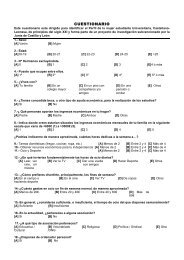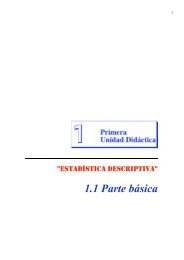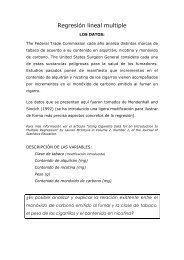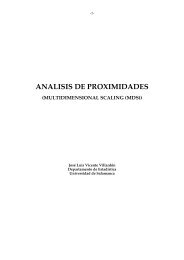Distribuciones de probabilidad - Estadística
Distribuciones de probabilidad - Estadística
Distribuciones de probabilidad - Estadística
You also want an ePaper? Increase the reach of your titles
YUMPU automatically turns print PDFs into web optimized ePapers that Google loves.
0<br />
6.5<br />
" = 0.1314<br />
NORMALES N(7.5; 0.2)<br />
7 7.5 8 8.5 9 9.5 10<br />
M = 7.8 29<br />
! = 0.05(fijado)<br />
CIRROTICOS N(8.5; 0.6)<br />
Figura 3.18: Representación gráfica <strong>de</strong> la distribución <strong>de</strong>l diámetro <strong>de</strong> hematíes en las dos poblaciones.<br />
Prefijado α queda <strong>de</strong>limitado el valor <strong>de</strong> M y el valor <strong>de</strong> β<br />
Al observar esta situación podríamos pensar en ser más restrictivos y prefijar un<br />
error α más pequeño, por qué no un 1% por ejemplo.<br />
¿Por qué habríamos <strong>de</strong> arriesgarnos en <strong>de</strong>clarar enfermos a un 5% <strong>de</strong> los sanos, lo<br />
que socialmente podría tener connotaciones negativas (<strong>de</strong>claramos cirróticos a<br />
individuos que no lo son), si po<strong>de</strong>mos prefijar este error tan pequeño como queramos.?<br />
Desafortunadamente disminuir el α trae consigo aumentar el β.<br />
Observemos qué ocurriría si quisiéramos disminuir cualquiera <strong>de</strong> los errores, por<br />
ejemplo ¿qué ocurriría si disminuyésemos α?:<br />
En efecto:<br />
Si α disminuye, β aumenta<br />
Si ! disminuye, por ejemplo ! = 1% , M aumenta.<br />
Veamos como esta afirmación es cierta. Realizar este cálculo es idéntico al caso<br />
anterior sólo que ahora la regla <strong>de</strong> <strong>de</strong>cisión es distinta:<br />
211









